The 1960s were a turning point for modern music. The same thing could be said about the 1970s, although the 1960s was the decade when some of the best rock bands were formed. And no matter what genre you like today, you should be grateful for Pink Floyd’s work. Starting back in 1965, the band featured Syd Barrett on guitar and vocals, Roger Waters on bass and vocals, Richard Wright on keyboards, Nick Mason on drums, and a lesser-known musician named Bob Klose on guitar.
Playing some pretty innovative psychedelic rock for the era, the band evolved significantly when David Gilmour joined the band in 1967. Meanwhile, Syd Barrett’s animosity grew and he eventually left the band, returning only to visit the band when they were (appropriately enough) recording the “Wish You Were Here” album.
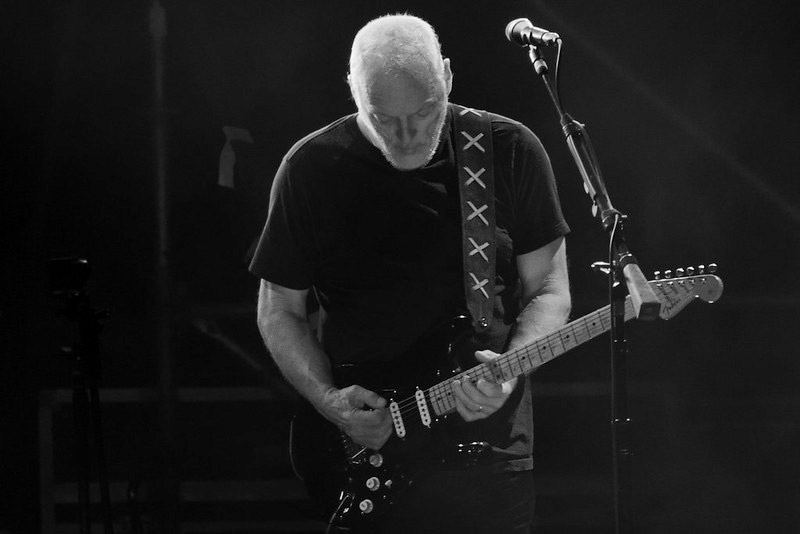
As time went by, Gilmour’s influence on the band’s overall output was more and more noticeable. It didn’t take long for his impeccable guitar-playing and songwriting skills to shine, especially on a record like “The Dark Side of the Moon.” A huge part of his work is his tone. It’s subtle, with nuanced differences between song sections, although it helps him paint a full picture for every song where he appears. So it’s no surprise that plenty of people have tried to copy it. With all this said, we’ll be exploring all of David Gilmour’s most notable gear that we were able to find, including his guitar, amplifiers, as well as numerous effects units.
What Guitar Does David Gilmore Play?
David Gilmore is best known for playing Fender Stratocaster guitars. His most notorious guitar is a 1969 Fender Stratocaster known as The Black Strat. He also has a vast collection of guitars that he has used over the years which includes several other Strats, Telecasters, Les Pauls, and more.
See the full list of notable David Gilmore guitars below.
1969 Fender Stratocaster, aka “The Black Strat”
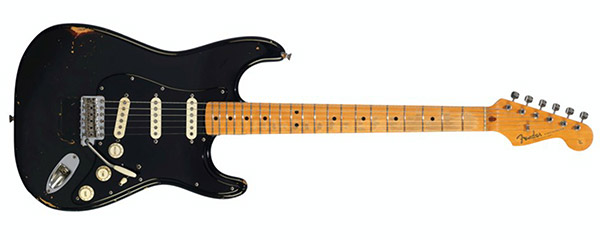
Finish: Black
Years used: 1970 to 1984, 1997 to 2019
Gilmour’s black ’69 Strat has a long history and is considered to be one of the most important guitars in history. Some guitar lovers have even documented its history in detail. David bought the instrument in 1970 after his white Strat got lost. Over the years, the instrument got some significant modifications. It was originally in sunburst, which Gilmour changed not long after the purchase. It changed many different necks and pickups over the years. Essentially, only its body remains original.
David used it until the mid-1980s when he gave it to Hard Rock Cafe. The guitar was given back to him in 1997 and he used it until 2019 when it was sold at an auction to American businessman Jim Irsay, reaching a head-spinning price of almost $4 million and becoming the most expensive guitar at that point in history. Interestingly enough, the record was broken only a year later with Kurt Cobain’s ’59 Martin D-18E that reached the $5 million mark.
1984 Fender Stratocaster V57 (the ’57 reissue), aka “The Red Strat”
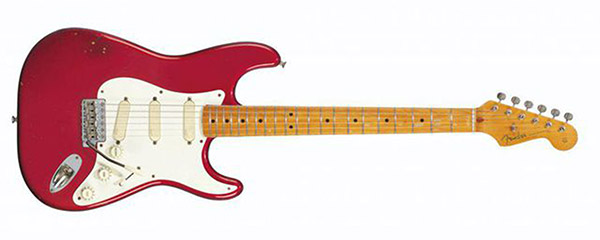
Finish: Candy apple red
Years used: 1984 to 2019
Another guitar Gilmour is well-known for is his legendary red Fender Stratocaster. Made back in 1984, it’s a V57 model, the reissue of 1957 Strat models. Once again, we have an instrument with a rich history and many modifications made to it. In fact, this is one of three of these that Gilmour acquired back then.
One of the most important modifications was the inclusion of EMG SA active noiseless pickups. Aside from having very expressive dynamic qualities and a great tone, they’ve helped him significantly minimize that annoying hum noise that single-coil pickups are known for. The Red Strat was also sold at an auction in 2019, reaching the price of $615,000.
1954 Fender Stratocaster, aka “#0001”
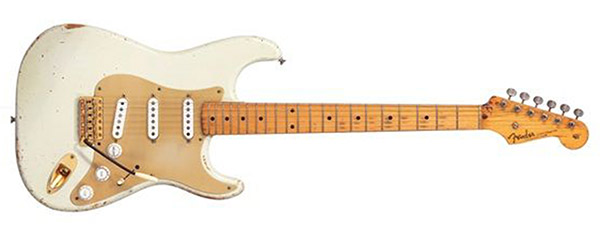
Finish: White
Years used: 1974 to 2019
Another Strat that Gilmour sold on the 2019 auction is the ’54 model, popularly bearing the 0001 serial number. Contrary to some theories, this isn’t the first Stratocaster ever sold since the model has already been in a few years into production by 1954.
The instrument is easily recognizable for its white finish and golden hardware. The exact origins of this instrument are theorized. The story goes that the 0001 Strat has only the original body, while the neck is from another model. Be that as it may, the guitar was sold for $1,815,000 at the 2019 auction. This is definitely one of my favorite David Gilmour guitars of all time.
1955 Fender Esquire, aka “The Workmate”
Finish: Worn-out vintage sunburst
Years used: 1973 to Present
Now, this is one of Gilmour’s most cherished and underrated instruments. The guitar in question is the Esquire model made in 1955. While these guitars originally had just one pickup, which made them different compared to Telecasters, Gilmour added another single-coil in the neck position.
Interestingly enough, the guitar was previously owned by none other than Seymour Duncan himself. What’s also really interesting is that its finish is quite rare, with Fender making only a limited run of these back in the 1950s. This kind of a finish was later introduced to Telecasters and other models in 1959.
As for Gilmour’s use of it, the Esquire saw some action on his first two solo albums, in 1978 and mid-1984. Later on, he used it for some live shows and tours but didn’t want to risk taking it on the road too much.
1953 and 1955 Gibson Les Paul Goldtop
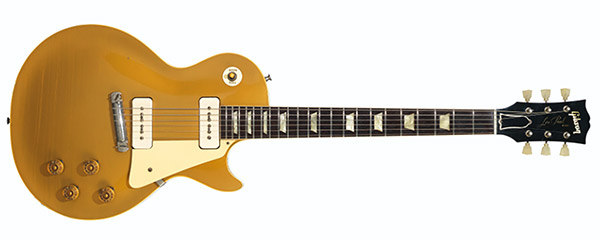
Finish: Gold
Years used: 1978 to 2019
While Fender guitars pretty much marked his career, Gilmour actually had some Gibson Les Pauls in his collection over the years. The one that really takes the spotlight is the legendary ’55 Goldtop with two P90 pickups and a simple vintage wrap-around stopbar bridge. his ’53 Goldtop looks similar except for the noticeable difference being the Bigsby tremolo bar.
The guitar’s shining moment was its use on “Another Brick in the Wall (Part 2)” for the well-known guitar solo. Although you could easily mistake its tone for a classic Strat, it’s the P90 neck pickup responsible for the bright yet somehow smooth tone.
The 1955 Goldtop saw extensive use over the years but was eventually sold at the famous 2019 auction. Needless to say, it surpassed all expectations and reached the price of $447,000. His 1953 Goldtop sold for another $250,000
1960s Fender Telecaster
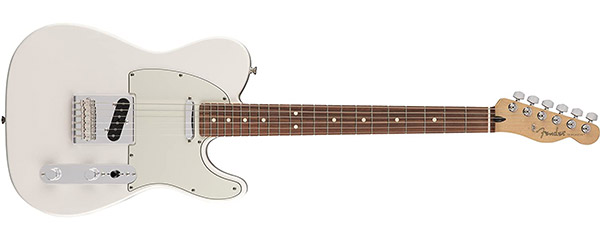
Finish: White
Years used: 1968 to Unspecified
Unfortunately, David Gilmour didn’t have much luck when he joined Pink Floyd. The aforementioned ’66 or ’67 Fender Stratocaster was a replacement for a ’60s Fender Telecaster that he lost during his early days in the band. This was, reportedly, due to an airline company’s mistake.
According to David’s words, this was the first proper guitar that he owned. Recognizing his talents, Gilmour’s parents bought him this fine guitar for his 21st birthday back in 1967. It featured a completely white finish with a white pickguard. Although the exact year of production is not known, the guitar has (or had, since no one knows where it is) a rosewood fingerboard instead of a “standard” maple one.
Custom Made Dual-Neck Stratocaster
Finish: Black
Years used: 1971 to 1979
Double-neck guitars became increasingly popular in the 1970s, mostly due to Jimmy Page’s use of his custom-built Gibson EDS-1275. Gilmour began exploring these territories as well in the early 1970s with a custom-made Strat model made by luthier Dick Knight. The body is completely custom-designed, while its necks come from actual Fender Strat guitars. Although both necks feature six strings, the lower part of the guitar had significantly higher action and was intended for slide guitar parts.
For some reason, the guitar wasn’t used very long, with Gilmour retiring it in the mid-1970s. Its current whereabouts are unknown.
1959 Fender Telecaster Custom
Finish: Sunburst
Years used: 1977 to Present
Although Gilmour is mostly known for Strats, there are great Telecasters that passed through his vast collection aside from the old lost white one. In the 1970s, he got a wonderful-looking sunburst Fender Telecaster. However, as it usually goes with David’s instruments, it’s a “Frankenstein” guitar made out of different components. But it’s the guitar’s finish and binding that makes it look unique.
For a while, he even used Gibson’s classic PAF in the neck position. The instrument also bears a neck with a rosewood fingerboard, which is a trait of Fender’s 1960s guitars. This Tele is best-known for its use on the “Animals” record and is most likely still in Gilmour’s possession.
Fender Stratocaster from 1960s
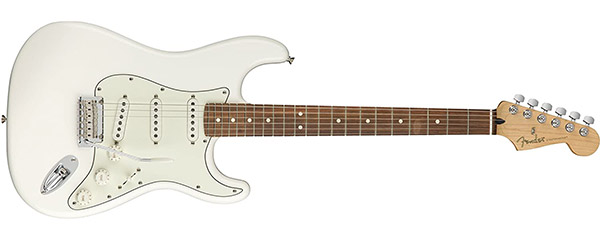
Finish: White
Years used: 1969 to 1977
Of course, David Gilmour is best known for his use of Fender Stratocaster guitars over the years. After joining Pink Floyd, Gilmour’s new bandmates gave him a Strat, made sometime in the mid-1960s. While the exact year of production is uncertain, experts have narrowed it down to 1966 or 1967. It bears that larger headstock and it came without the “bullet” truss rod. Additionally, being from the 1960s, this Strat has a rosewood fingerboard instead of a maple one. It came with a completely white body, accompanied by a white pickguard.
Although it served him quite well, starting in 1968, the instrument was eventually stolen in May 1970 while Pink Floyd was on their US tour. In fact, most of the band’s gear was stolen but was later returned to them. Unfortunately, the white Fender Strat was never found and its whereabouts still remain a mystery to this very day. However, what’s important is that the instrument was his first Strat, eventually becoming David’s staple guitar model.
1952 Reissue Fender Telecaster
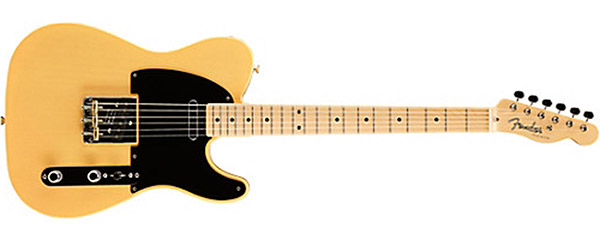
Finish: Butterscotch
Years used: 1982 to Present
Another interesting Telecaster in his collection, Gilmour had a ’52 reissue model with a butterscotch finish that he used on live shows. Interestingly enough, the instrument was usually tuned to drop D, which was done especially for performances of Pink Floyd’s “Run Like Hell.” Overall, there haven’t been any significant modifications to this instrument, at least not any worth documenting. It saw occasional appearances in the 2000s, although it mostly served as a backup guitar. It’s not certain whether this instrument is still in his possession. Although we have no doubts that it’s a great Telecaster, it’s far from a historically important one compared to his other Teles and Strats.
Bill Lewis 24-Fret Custom Guitar Model
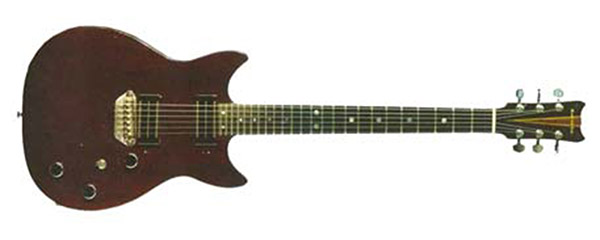
Finish: Natural brown
Years used: 1972 to Present
While custom-made instruments by small independent luthiers weren’t as widespread back in the day, David Gilmour got one special guitar made by Bill Lewis in 1970. This is a double-cutaway instrument with a slight resemblance to the classic SG body shape, bearing 24 frets, which was quite rare at the time. Although not as popular and widely known as his Strats or Teles, the guitar was crucial for the recording process of “The Dark Side of the Moon.”
What also made it really special is the fact that it included the coil-splitting feature, as well as some incredible ergonomic features, supposedly even a compound-radius fretboard.
Gretsch G6128T Duo Jet
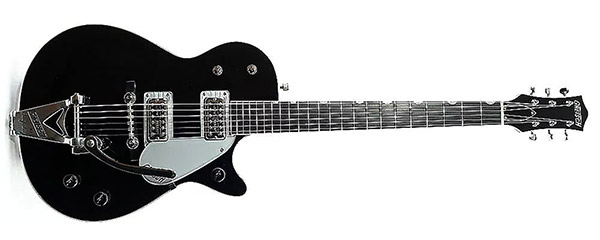
Finish: Black
Years used: 2005 to 2019
Although it’s not that widely known among guitar lovers, David Gilmour actually had some interesting Gretsch guitars. But while most of them didn’t see extensive use, there’s one Duo Jet, the G6128T model, that David used for live shows in the 2000s. It features a completely black finish, a white pickguard, and a Bigsby tremolo bridge and tailpiece system. It’s not certain whether he changed anything on it, but it seems like he kept the Filtertone pickups that came originally with it. Built back in 2005, Gilmour sold it at the 2019 auction for over $60,000.
Popular Related Article: Jimi Hendrix Guitars and Gear Overview
Gibson J-45
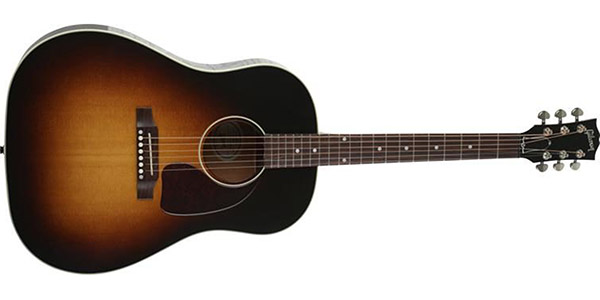
Finish: Vintage two-tone sunburst
Years used: 1973 to Unspecified
As far as acoustic guitars go, Gilmour had some interesting Gibsons over the years. One of the first he was ever seen with was the J-45 model back in the early 1970s. There have been some more recent uses of similar Gibson models, although they’ve never been publically discussed. Anyhow, this particular guitar was mostly used for live shows at the beginning of the ’70s and it’s not exactly certain whether it appeared on any studio recordings at all.
Mid-1980s Gibson J-200 Celebrity
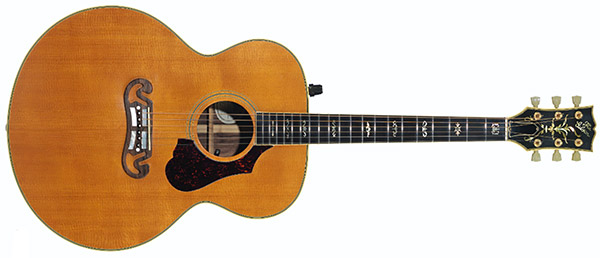
Finish: Natural
Years used: Mid-1990s to Present
Back in 1984 and 1985, Gibson made a very limited run of only 90 J-200 Celebrity acoustic guitars. According to one 1995 interview with his guitar tech Phil Taylor, three of these were acquired by Gilmour around that time. Apparently, the Pink Floyd guitarist loves how they sound and feel.
Of course, they saw some modifications from the very beginning. According to Taylor, they were immediately equipped with EMG preamp and pickup systems and even feature small Crown microphones in them for that super-realistic sound when plugged in a mixing board. These are two completely separate systems, meaning that these guitars come with two output jacks.
Martin D-35
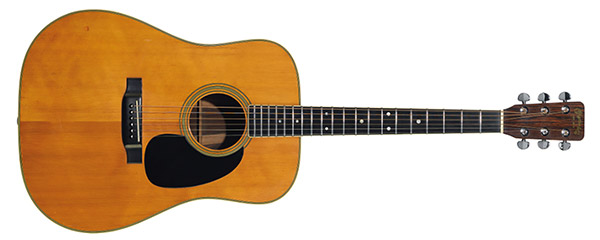
Finish: Natural
Years used: Unspecified
While we can’t say for sure when David Gilmour got his hands on this fine guitar, it’s known that he has Martin’s D-35. Of course, the greatness of Martin guitars needs no explanation as they’ve been used by some of the best musicians of all time.
Ovation Custom Legend 1619-4
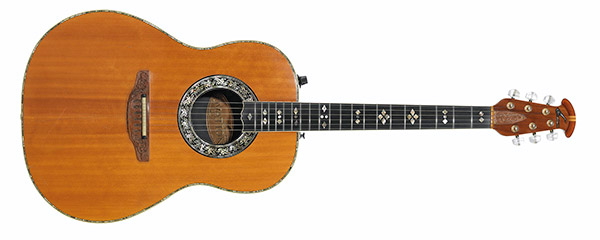
Finish: Natural with special pearl inlays
Years used: 1975 to 2019
Going deeper into his acoustic guitar collection, one important instrument in there was his Ovation Custom Legend 1619-4. The instrument is known for its eye-pleasing inlays on the top of the body and the fretboard, which all go perfectly with the instrument’s natural finish and white binding. There’s also a specially-designed wooden bridge that rounds up its design. Other than that, it also features the rounded back and that easily-recognizable Ovation headstock design. While we can’t confirm the info, there are some stories about this guitar being used for “Comfortably Numb” sessions. Either way, the guitar was sold at his 2019 auction for $150,000.
Popular Related Article: Tony Iommi Guitars and Gear Overview
Taylor 712CE
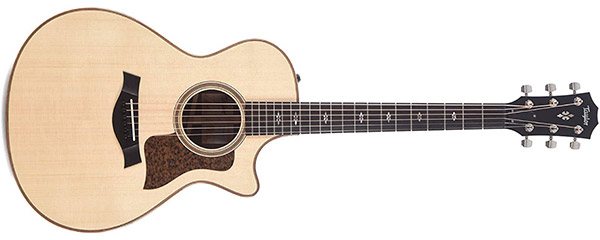
Finish: Natural
Years used: 2001 to 2005
For his early 2000s shows, David Gilmour used a Taylor 712CE guitar. Once again, we have an acoustic guitar with a single-cutaway design. In this case, it’s a Venetian cutaway. Bearing a natural finish, we have a brighter-colored top and darker brown sides, all accompanied by very stylish multi-ply binding. It comes with a special spruce top, Indian rosewood back and sides, as well as V-style bracing. This is all accompanied by Taylor’s special electronics and pickup system. However, Gilmour used it for a relatively brief period, most likely just in 2001 and 2002.
Table Showing the Guitars David Gilmour Used at Each Point in His Career
| Make | Model | Color/Finish | Years |
|---|---|---|---|
| Fender | 1969 Stratocaster, aka “The Black Strat” | Black | 1970-2019 |
| Fender | 1984 Stratocaster V57 (the ’57 reissue), aka “The Red Strat” | Red | 1984-2019 |
| Fender | 1954 Stratocaster, aka “#0001” | White | 1970s-2019 |
| Fender | 1955 Esquire, aka “The Workmate” | Sunburst | 1970s-Present |
| Gibson | 1953 and 1955 Les Paul Goldtop | Gold | 1970s-2019 |
| Fender | 1960s Fender Telecaster | White | 1960s |
| Fender | Custom Made Dual-Neck Stratocaster | Black | 1970s |
| Fender | 1959 Telecaster Custom | Sunburst | 1970s-Present |
| Fender | 1960s Stratocaster | White | 1960s-1970s |
| Fender | 1952 Reissue Telecaster | Butterscotch | 1980s-Present |
| Bill Lewis | 24-Fret Custom Guitar Model | Natural | 1970s-Present |
| Gretsch | G6128T Duo Jet | Black | 2005-2019 |
| Gibson | J-45 | Sunburst | 1970s |
| Gibson | Mid-1980s J-200 Celebrity | Natural | 1990s-Present |
| Martin | D-35 | Natural | unknown |
| Ovation | Custom Legend 1619-4 | Natural | 1970s-2019 |
| Taylor | 712CE | Natural | 2000s |
David Gilmour Gear and Amps
Hiwatt DR103
Years used: 1960 to 1987, 1994 to Present
As far as amplifiers go, Hiwatt’s DR103 has been Gilmour’s go-to model since 1969 and up to 1987. Although abandoning them for a while, he once again included these amps on the 1994 “Division Bell” tour. In fact, there were actually six of these in two separate racks for his live setup, plus backup ones he took with him on the road. After returning to them in the 1990s, he’s been using them ever since.
Interestingly enough, Gilmour prefers to use them with old tubes, giving him the kind of tone that he prefers. According to some information available online, he mostly uses models made back in 1974 today. They’re paired with Hiwatt’s WEM 4×12-inch cabinets.
Bearing 12AX7 tubes in the preamp and EL34S JJ tubes in the power amp section, these are still highly valued among collectors, often reaching prices of a few thousand dollars.
Mesa Boogie Mark I
Years used: Mid-1980s to the mid-1990s
Since Mesa Boogie made a huge breakthrough on the market in the 1980s, it was only a matter of time until David Gilmour would use one. Although mostly known for their “tight” tone, these were pretty versatile for the era and were used by anyone from jazz guitarists and up to thrash metal titans.
As far as Gilmour’s rig goes, he preferred to use the good old Mark I model. According to some of his old photos, there was at least one of these in his live rigs labeled as “fuzz.” The story goes that it was technically used as a fuzz effect in his signal chain. Although the Mark I amp was launched back in the early 1970s, Gilmour seemed to prefer its tone over their newer models at the time, like the Mark IIC+. It was a part of his rig until the mid-1990s when he came back to Hiwatts.
Fender Twin Reverb Head
Years used: Mid-1980s to mid-1990s
Since Gilmour is a fan of Fender guitars, there have been some of Fender’s amp models in his collection as well. One of the models was the legendary old Twin Reverb head. He had at least a couple of these in his live rig for “A Momentary Lapse of Reason” tour, as well as for the “Division Bell” tour.
These are classic traditional “American” amps with 100 watts of power and two channels, one normal and with the vibrato effect. It’s very well-known for its bass-oriented tone with the addition of piercing high-ends, as well as a saturated reverb effect.
Gallien-Krueger 250ML
Years used: 1983 to 1988
Now, here’s one pretty rare amp that Gilmour used in the 1980s. It’s assumed that this one was a part of his live rig for the “About Face” album. But what’s really interesting, and not typical for a bluesy-oriented guitar player like David, is that this is a relatively cheap solid-state amp. It comes with 100 watts of power, two channels, and even a direct output. What also made it interesting is the 4-band equalizer that allowed for some more detailed tone-shaping.
According to Gilmour, he used the amp’s distorted channel for Pink Floyd’s “Sorrow” from “A Momentary Lapse of Reason” album.
Fender Twin Tweed
Years used: 2003 to 2009
Another interesting Fender amplifier that passed through David’s collection is the Twin Tween combo. While it’s not certain for how long he used it, or whether it actually saw any action in the studio or on live shows, it’s not surprising to know that he had one. The story goes that he tried to use it for his solo album “On an Island” but that he couldn’t get it to sound the way he wanted. Needless to say, he went with his good old Hiwatt amps.
These Fender Twin Tweed amps were originally made between 1952 and 1963. They’re very well-known for their 6L6 tubes in the power amp section, giving them the classic Fender tone.
David Gilmour Pedals and Effects
Electro-Harmonix Big Muff Pi (Including Many Different Variants)
Years used: 1977 to Present
Just like he’s known for using various Fender Stratocaster guitars, Gilmour is also an avid fan of Electro-Harmonix’s legendary Big Muff Pi distortion pedals. Originally launched way back at the end of the 1960s, it pretty much changed the guitar industry. Technically, this was the first-ever pedal marketed as a standalone distortion device.
As for Gilmour, he has had several different models in his collection, some of which have been modified by Pete Cornish. He reportedly started using them on the “Animals” album, although the best-known implementation was the “Ram’s Head” version for the solo on “Comfortably Numb.” Big Muff Pi has remained the crucial part of his signal chain even to this day.
Electro-Harmonix Electric Mistress V2
Years used: 1973 to 1999
Of course, Big Muff Pi isn’t the only Electro-Harmonix pedal that Gilmour loves. One of the company’s other devices that pretty much marked Pink Floyd’s peak period was the Electric Mistress. Used from the late 1970s and during the early 1980s, Gilmour made some of the finest flanging tones in the world of rock music. The particular version he had was the V2, which had a somewhat chorus-like effect. It was a crucial part of his live setup, although it also found ways onto “The Wall” record, Gilmour’s debut solo album, as well as on “The Final Cut.”
Colorsound Powerboost
Years used: 1972 to 1978
Back in the old days, guitar players had a hard time creating heavy distorted tones. What’s more, they didn’t have much to choose from and the availability of different distortion devices wasn’t all that great. But one of the most common ways was to use a simple clean boost pedal which would increase the input signal being fed into an amplifier, driving tubes over the edge, and resulting in that “organic” distorted tone. Gilmour had a simple Colorsound Powerboost throughout most of the 1970s, finding its way on both studio sessions and live shows. This simple pedal was designed by Gary Hurst, known for his legendary Sola Sound Tone Bender, back in the late 1960s. It features a 2-band EQ and a simple boost knob.
Popular Related Article: Jimmy Page Guitars and Gear Overview
Boss FZ-2 Hyper Fuzz
Years used: 1996 to 2009
When it comes to distortion, Gilmour seems to have always preferred fuzzy tones over those “conventional” hard-clipping distortion pedals. It’s been confirmed by his tech Phil Taylor that David used Boss’ FZ-2 Hyper Fuzz.
Launched back in the early 1990s, this pedal was the meeting point of old school and more modern-sounding fuzz tones. And while we’re mostly used to having rather simple fuzz pedals with rudimentary controls, this one came with a couple of more features, including a 2-band EQ and a switch that lets you select between three different modes of operation. It was sold only for four years during the 1990s.
Blackstar HT Dist
Years used: 2010s
While there’s not any information when and where exactly Gilmour used it, there are photos of his pedalboard with Blackstar’s HT Dist pedal. Well-known for its amplifiers, the company used some of the same practices in their pedal-making process, bearing one 12AX7 preamp tube in its circuitry.
Contrary to what many may assume, this isn’t actually your average distortion pedals but rather a preamp. Sure, you can use it as a regular pedal, going straight into the amplifier input. However, there’s an additional output with a cabinet simulator allowing you to go straight into a mixer or your amp’s power section.
Boss HM-2 Heavy Metal
Years used: 1984 to 1989
Believe it or not, David Gilmour actually used Boss’ HM-2 Heavy Metal pedal. What’s more, he used it in combination with his Mesa Boogie amp, as well as his fuzz pedals. The main idea was to keep the heaviness but still smoothen out all the “unpleasant” frequencies of fuzz pedals. Gilmour had it for his solo album “About Face,” as well as Pink Floyd’s “A Momentary Lapse of Reason.”
Boss MZ-2 Digital Metalizer
Years used: 1988 to 2003
Another unexpected pedal is Boss’ MZ-2 Digital Metalizer. This isn’t just a distortion device as it comes with additional chorus and “doubling” modes. It’s not exactly certain how he actually used it in combination with other effects, but it saw some action on “A Momentary Lapse Of Reason” tour back in the late 1980s and the very start of the 1990s.
Boss DD-2 Digital Delay
Years used: Unspecified
While we can’t say for sure for how long Gilmour has been using Boss DD-2 Digital Delay, the pedal was seen on photos of his 2015 live rig. Looking at some of his other pedals, he seems to really like some of the 1980s effects so we wouldn’t be surprised if he kept DD-2 since that era. This one is the first-ever digital effect by Boss and it was succeeded by DD-3, which is essentially the same exact model with a new name.
Univox Uni-Vibe
Years used: 1973 to 1978
Aside from Gilmour’s obsession with EHX devices like Big Muff Pi and Electric Mistress, he also extensively used Univox’s Uni-Vibe pedal back in the 1970s. Originally intended for organ players, this is one of the most revolutionary effects in the world of guitar and was used by plenty of guitar legends in the 1960s and the 1970s. While used as a chorus and vibrato effect, this is technically a phase shifter with a rather unique tone. The lo-fi throbbing tones seem to have been a perfect addition to Pink Floyd’s music as the pedal found its way on “Obscured by Clouds” and “The Dark Side of the Moon.”
Effectrode Tube-Vibe
Years used: 2010s
A great alternative to the legendary Uni-Vibe is Effectrode’s Tube-Vibe, which was seen on some of Gilmour’s more recent live setups. This is technically a tube-driven preamp with three 12AU7 tubes in its circuitry. The unit is open for some minor tweaking as you can also swap 12AU7s for the classic 12AX7s and get some of those Leslie-like sounds. Although copying the old Uni-Vibe device, it comes with some more versatile tone-shaping options.
Binson Echorec 2
Years used: 1973 to 1985
Back in the 1960s and the 1970s, tape-based units were the only way a guitar player (or any other instrumentalist) could achieve the echo effect. Gilmour used Binson Echorec 2, which is well-known for its saturated tube-driven tone, along with those slightly “warped” and warm nuances. If you stumble upon one of these today, they could easily reach prices of a few thousand dollars or more.
EMS Hi-Fli
Years used: 1970s
Another rather unusual effect unit in Gilmour’s 1970s arsenal was the EMS Hi-Fli, popularly known as “The Sound Freak.” While it was often referred to as a synth, it’s technically an analog multi-effects device. Well, it’s not like the stuff we have today as you’d need to adjust the sliders in order to change the tone. Nonetheless, some of the parameters were controlled using expression pedals. It featured a top boost, octave shifter, a “buzz” switch, ring mod, attack rate, decade rate, and plenty of other controls.
Wrap Up
After “Dark Side of the Moon” the world was gifted with more of Gilmour and Pink Floyd’s great works, anything from “Animals” and “The Wall,” all the way to somewhat controversial “A Momentary Lapse of Reason” and “The Division Bell” albums that were written and recorded without Roger Waters in the band. The band’s third album with Gilmour as the leader was “The Endless River,” which came out in 2014. Of course, Gilmour also released his four incredible solo records, starting with 1978’s eponymous album.
But be it his solo records or Pink Floyd albums, one thing always remained the same – you could always easily recognize Gilmour’s playing. No, it doesn’t mean that it was repetitive, but it’s just that it has its character. One of his most important traits is expressiveness and how his rhythm and lead sections serve the songs. He’s not a virtuosic “shredder” kind of guitar player. Nonetheless, his influence on guitarists of all genres, including metal music where musicians usually play fast, is immense. As far as his technique goes, his intonation in his long and far-reaching string bends is impeccable. Gilmour’s expressiveness is also heard in his dynamics, where he fully implements the potentials of his guitars, amps, and effects. Although it might seem simple to some, no one can really write and perform music the way Gilmour does.

My name is Chris and I’ve had a passion for music and guitars for as long as I can remember. I started this website with some of my friends who are musicians, music teachers, gear heads, and music enthusiasts so we could provide high-quality guitar and music-related content.
I’ve been playing guitar since I was 13 years old and am an avid collector. Amps, pedals, guitars, bass, drums, microphones, studio, and recording gear, I love it all.
I was born and raised in Western Pennsylvania. My background is in Electrical Engineering, earning a Bachelor’s degree from Youngstown State University. With my engineering experience, I’ve developed as a designer of guitar amplifiers and effects. A true passion of mine, I’ve designed, built, and repaired a wide range of guitar amps and electronics. Here at the Guitar Lobby, our aim is to share our passion for Music and gear with the rest of the music community.

Great information. Loved the pictures and history.
I have a 1970 Bill Lewis guitar identical to the guitar you described used on Dark Side of the moon. This guitar is very rare and I cannot find anyone able to give me an appraisal of the current value. If you can help please email me.
Thank you
Barry
The Ovation 1619-4 that was used by Gilmour to write Comfortably Numb was sold at the Christie’s auction in New York for $ 440,000.00
I registered to bid on that guitar which at the time a non-celebrity one could be bought for $800-$900, and Christies estimated his to go between $4K and $5K at auction.
Well that one went out the window for me. I put a high bid of $5,500.00 but that went by the wayside in the first 10 minutes of the auction, cracked soundboard and all!